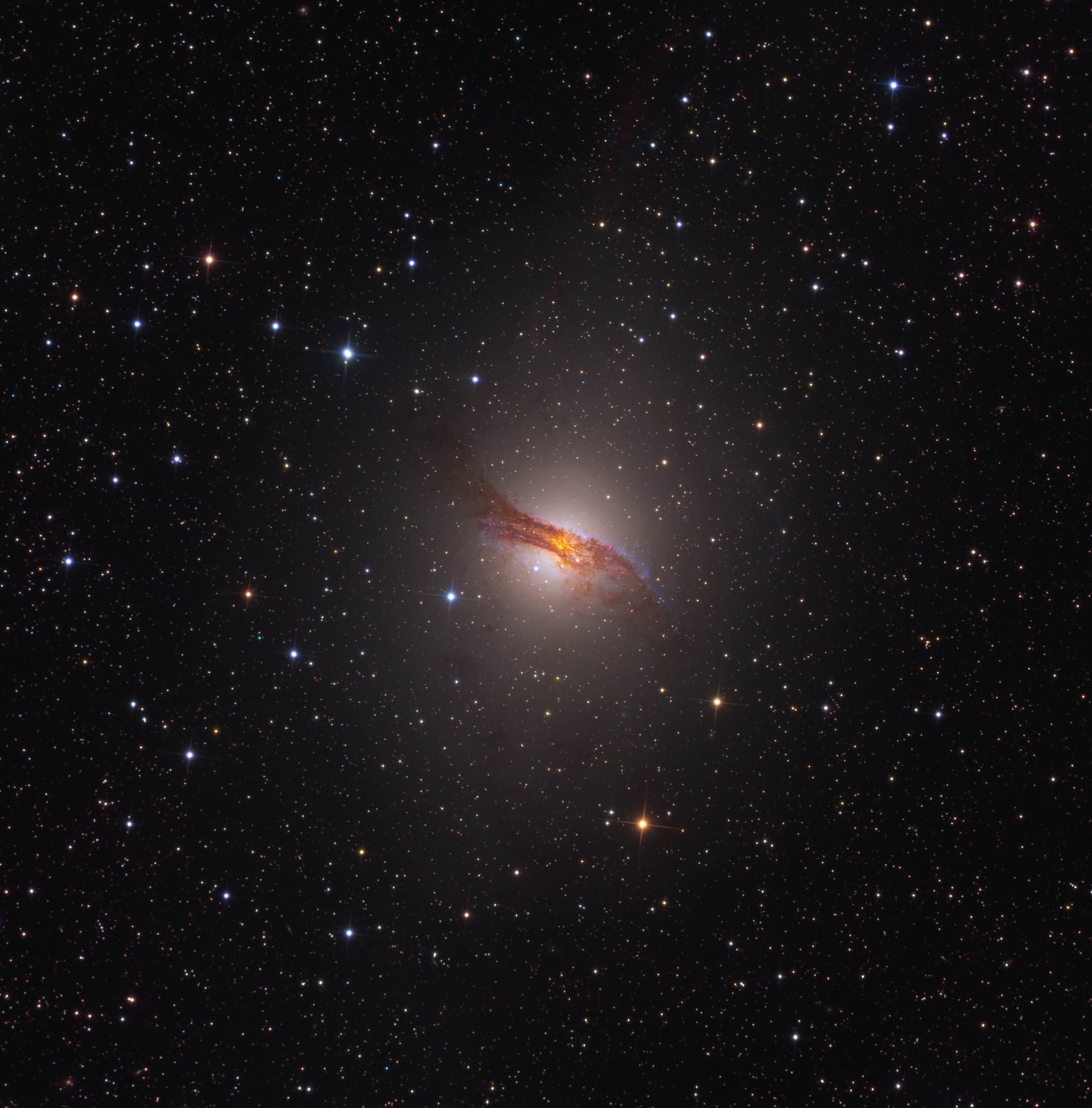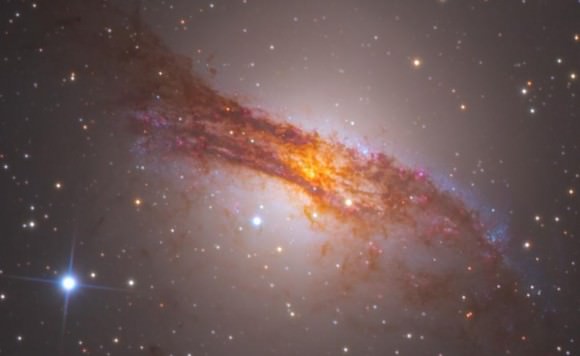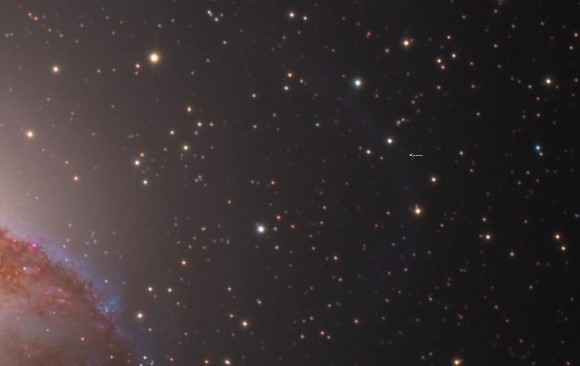“I’m on rhe outside… I’m lookin’ in.” And just who are we looking in at this time? None other than the familiar face of Centaurus A.. The stunning, turbulent dust lane is cloaked in the ethereal mist of living galaxy stuff – the result of a gravitationally hungry elliptical galaxy drawing a smaller companion spiral galaxy towards its demise. Like a spider waiting in the center of a web, the black hole at the heart of NGC 5128 takes no prisoners. Its complexity screams out to us in radio, X-ray, and gamma-ray energy. “I can see through you… See the real you.”
It waits in space some 10 to 11 million light years away. It’s the nearest active galaxy to Earth and contains a core black hole estimated to be a billion times the mass of our Sun. The result of Centaurus A’s merger event is so incredibly powerful that it may have even shifted the axis of the massive black hole from its expected orientation – an area not much larger than our own solar system. “The variability of the nucleus may represent the accretion of individual stellar or cloud remnants onto the black hole triggering renewed jet activity and fueling the radio source.” says F.P. Israel. “Details of these processes are not clear yet, but careful and frequent monitoring of Centaurus A at radio, X-ray and -ray wavelengths may provide important information. For instance, how does the nucleus drive the nuclear jets, and how are the relativistic nuclear jets transformed into the nonrelativistic inner jets? The circumnuclear disk does not seem capable of controlling the collimation of the nuclear jets, but its orientation exactly perpendicular to these jets, suggests that it is somehow connected with the collimating agent.”
Could it be the unique properties of Centaurus A originate from its cannibalizing an equally unique galaxy? If you examine the full size image by Ken Crawford you’ll find many background galaxies hidden amongst the stars. What we may very well be viewing is the early results of an giant elliptical merging with a much small spiral structure – creating a stunning halo. “When most people think of NGC 5128 (also known as Centaurus A) they see radio jets, central black holes, a very visible accretion disk and more. But these are “icing on the cake” of the underlying giant E galaxy.” says Gretchen Harris (University of Waterloo). “We now know the it has a fairly normal old halo system as seen in its globular clusters, planetary nebulae, and red giant stars. Its proximity makes NGC 5128 an ideal template for understanding the properties of large E galaxies in general.”
While science may consider Centaurus A to be a template, its tortured form makes it an incredible palette to the eye of the camera. Utilizing a RCOS 14.5″ Truss telescope and taking various exposures for nearly two hours, Ken has produced an image which reveals intricate details almost as fine as the 7 light-year resolution photos taken by the Hubble Space telescope.
Here you will see clumps of hot, young blue stars which have newly formed and the pink signature of star forming regions – as well as the release of gas which hasn’t conformed to the spin axis of the central black hole. Maybe two black holes duking it out? “This black hole is doing its own thing. Aside from receiving fresh fuel from a devoured galaxy, it may be oblivious to the rest of the galaxy and the collision,” said Ethan Schreier of the Space Telescope Science Institute. “”We have found a complicated situation of a disk within a disk within a disk, all pointing in different directions. It is not clear if the black hole was always present in the host galaxy or belonged to the spiral galaxy that fell into the core, or if it is the product of the merger of a pair of smaller black holes that lived in the two once-separate galaxies.”
Although the galactic merger may have began around 200 to 700 million years ago, the incredible arcs of multi-million degree gas remain in a 25,000 light-year diameter wobbling ring producing high energy jets. Given its size and location this ring might very well be a galaxy-sized shockwave – the million mile per hour outward ripples of an intense explosion which may have occurred some 10 million years ago. “We believe that most of these stars formed from the interaction of the jet with local concentrations of dust and gas.” says John Graham. “The brightest blue stars are presumably the youngest stars and tend to lie close to the X-ray jet. We suggest that the raw material for star formation is found in dust patches of small angular size in the area and that star formation is triggered by shocks initiated by the jet.”
Now I want you to take a closer look. What you are going to discover (highlighted by the small arrow) is a thin, blue smear of newly formed stars. It’s something you’d probably never notice unless it was pointed out to you.
What you are seeing is a thousand light year long band of scar tissue. A dead giveaway of a recent galactic absorption. Astronomers had previously noticed the arc now identified as a galactic merger remnant, but without recognizing its origin. “This adds a nice example in the local universe to the growing evidence that galaxy halos are built up from the accretion of dwarf satellite galaxies,” said Eric Peng, a graduate student in astronomy at Johns Hopkins University. “These halos are interesting partly because they’re hard to study, but also because time scales for things to happen in halos are very long, which means they may preserve conditions that reveal how a galaxy formed and evolved.”
But for now? “I’m on the outside… And I’m lookin’ in. I can see through you… See your true colors.”
Many thanks to Ken Crawford for his exquisite work which led to a wonderfully pleasant day of researching the ins and outs of a most remarkable galaxy!




Wow, nice piece Tammy. Some incredible images from Ken, too. It’s nice to compare these images with a deep color composite taken with the 4 meter Blanco scope at Cerro Tololo: http://www.noao.edu/image_gallery/images/d6/cena2.jpg
The blue arc, remnants of a disrupted dwarf galaxy, can be seen at the 1:00 position relative to the nucleus. Faint linear blue traces at the 11:00 position follow the path of the nuclear jet all the way to the edge of the field. These regions were found to contain turbulent hot x-ray emitting gas and young stars – a rare example of shock induced star formation. Also apparent are many shells, definitely a sign of a merger event. Quite a spectacle, and right in our back yard.
You’ve misspelled the name of the telescope. It is not “RCOSS” 14.5″ telescope, but “CROSS” :}
@Ravenas – No, Tammy was right, the RCOS 14.5 telescope she referred to -a Ritchey-Chrétien style open truss scope is manufactured by RC Optical Systems.
http://www.rcopticalsystems.com/telescopes/14truss.html I LIKE!
Centaurus A/NGC 5128 is located at 13h25m, -43 Deg. at mag. 7 On a side note, Omega Centauri is only about 4-5 degrees due South!
Here in No. Calif. I am at 38 Deg. 31′ N and have seen Omega Centauri several times… but have failed to look for Centaurus A – THAT won’t happen again! ~@; )
Aqua, I’ve seen them both in binoculars (a nice pair) and with an 8′ Celestron from central Ohio (40 degrees) on several occasions. If you’ve seen Omega Cen, Cen A should be no prob.
@Jon Hanford – Thanks for the tip! I dint know that at your latitude you would still able to see Omega Centauri! I’m still using my little 4″ Meade SC, bought in 1984. Funny thing about that is… at star parties, I’ve been derided at times for using such a small scope. BUT have found that during ‘bumpy’ or more turbulent upper atmospherics I have been able to resolve things like comets that 8″ and larger scopes had a hard time finding! I am still building a 12 1/2″ Newt… which has taken FAR TOO LONG to finish, no doubt due in part to the economic downturn I, like everybody else? has been experiencing.. dzzzzz. Now WHERE did I put my economy.. I KNOW I left it laying around here somewhere!